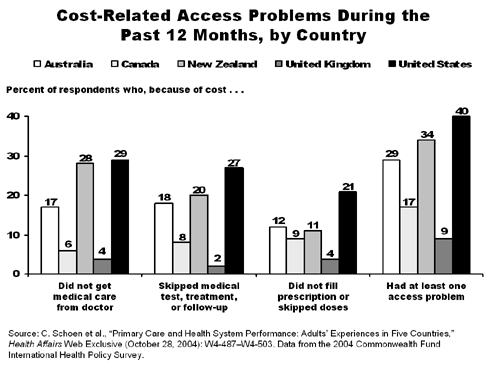In assessing adults' primary care experiences in the last three years in Australia, Canada, New Zealand, the United Kingdom, and the United States, the researchers found widespread concerns about gaining prompt access to a doctor when sick, delays in receiving lab test results and test errors, and physicians' failure to engage patients or promote health, as reported in "Primary Care and Health System Performance: Adults' Experiences in Five Countries" (Health Affairs Web Exclusive, Oct. 28, 2004). Americans reported cost-related difficulties accessing care at especially high rates. Lack of same-day appointment availability, long waits to see a doctor when sick, and reliance on the emergency room for routine care were also big problems in both Canada and the U.S.
The authors note that all five countries could do better. The survey findings, they say, underscore "the importance of examining international strategies that could be adapted and instituted at home."
Access to Care
Access to care is related to costs, and particularly to a nation's insurance system. Given often high uninsured rates and cost-sharing in the U.S., Americans were the most likely to report not seeing a doctor when sick, not getting recommended tests or follow-up care, or going without prescription medications because of high costs. The U.K., in contrast, showed negligible cost-related access problems, while the other countries stood in between the extremes. Timeliness of access was also a greater problem in North America than elsewhere. While the majority of adults in New Zealand and Australia said they received appointments on the same day when they were last sick and needed medical attention, only one-third or less of Canadian or U.S. adults reported such rapid entry.
Reliance on Emergency Rooms
Emergency rooms are a key access point for patients in crisis, but their use is also an indicator of how well a nation's care system is responding to patients' needs. ERs function as safety nets when timely access to primary care is not available. Though the survey found that adults in all five countries substituted ER visits for regular doctor care, Canadian and U.S. adults were more likely to have gone to the ER for care that regular sources could have provided, if available.
Coordination and Communication
The survey found coordination and continuity concerns in all five countries. Among adults with recent doctor visits, more than one of four reported that test results or medical records were not available at the time of a scheduled appointment, that they received duplicate tests or procedures, or that they received conflicting information. For each of these three measures, U.S. rates were higher than rates for three of the other four countries. Among patients taking prescription drugs on a regular basis, failures by physicians to review medications were frequent, and high proportions of these respondents also said that their doctor had not explained drug side effects.
The survey revealed doctors' missed opportunities to identify patient preferences or concerns, to communicate well, or to engage patients in care decisions. For example, one of five U.K. and U.S. adults said their doctors only sometimes, rarely, or never made treatment goals clear. Similarly, failure to engage patients in treatment plans was frequent in all countries, though highest in the U.K. and U.S.
Preventive Care
Preventive care was one area where the U.S. tended to lead or rank highly. The U.S. stands out for having the best rates of preventive care, such as Pap tests for women ages 25–64 and mammograms for women 50–64. However, shortfalls—such as in directing patients toward flu shots—were found in all five countries. At least half of respondents in each country said their doctor does not send reminders, has not recently provided advice or counseling on weight or exercise, or does not ask if emotional issues are affecting their health.
Conclusions
Respondents in the surveyed countries called for major reforms in their nations' primary care systems, with only a minority of adults saying they were "very con-fident" that they will get quality, safe medical care when needed. U.S. respondents, however, stood out as the most negative in their overall health system views. U.K. respondents had the most positive perspectives on their country's health system.
The report cites a variety of promising policy initiatives under way in each country that are aimed at addressing some of the noted deficiencies. Such efforts—ranging from incentive-based contracting with general practitioners in the U.K. to ER learning collaboratives in Australia—warrant tracking over time, the authors say, adding that all five nations should examine these and other international strategies for possible adapta-tion at home.
Facts and Figures
- One of five adults surveyed in the U.S. and Canada had to wait at least six days to get an appointment when sick.
- Eight to 15 percent of patients in all five countries said they were given incorrect test results or experienced delays in being notified about abnormal results.
- Only 37 percent of U.S. survey respondents reported that they had been going to their doctor or usual place of care for five years or more. By contrast, 50 to 63 percent of respondents in the other four countries reported the same.
- Between one-half and three-quarters of patients in the five nations said they had not received advice or counseling on weight, nutrition, or exercise—from 48 percent in the U.S. to 72 percent in the U.K.



